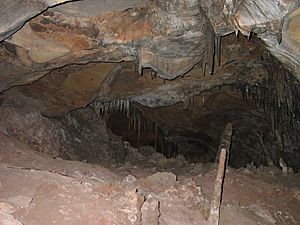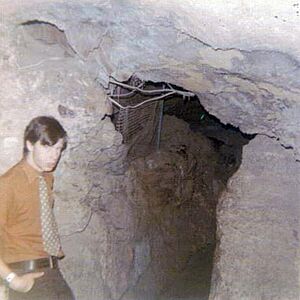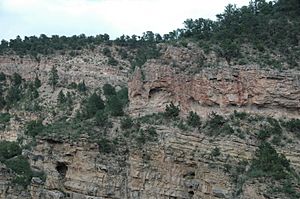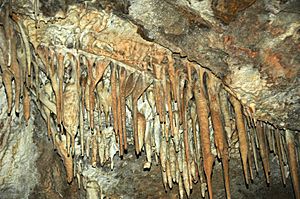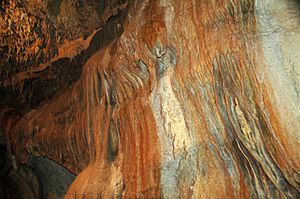Cave of the Winds (Colorado) facts for kids
The Cave of the Winds is an amazing cave system in the Pikes Peak area of Colorado. It's found just west of Colorado Springs, right on U.S. Highway 24. You'll find it close to the Manitou Cliff Dwellings. You can take tours through these cool caves every day! Inside, you'll see incredible rock formations called speleothems, which are like natural sculptures.
Contents
Exploring the Cave's Wonders
One of the most famous parts of the Cave of the Winds is the Silent Splendor room. It was found in 1984. This room has many rare and beautiful crystal formations. Some of these are called helictites. They look like they are growing in all sorts of strange directions, almost as if they are floating!
However, this special room is kept sealed off from visitors. This helps protect its delicate environment. A special "environmental gate" keeps the moisture inside. This moisture is super important for these fragile formations to keep growing.
Adventure and Discovery Rooms
In the late 1980s, new parts of the cave were opened. On May 8, 1988, a room called the "Adventure Room" became accessible. This room feels more natural than other parts of the cave. It has dirt floors and fewer lights. From here, you can go on "Lantern Tours" into the Manitou Grand Caverns.
In 1989, another new passage opened, named "Old Curiosity Shop." People say it's the narrowest path in the cave! As you go through, you can see the "Colorado Rose," which is a beaded helictite. You might also spot "Spider Web Valley," a collection of tiny, delicate helictites. This passage was made to make tours easier.
Fun Above Ground
Besides the cave tours, there's also a thrilling ride called the Terror-Dactyl. It's a free-fall amusement ride that offers a big rush!
A Look Back at History
It's believed that both the Apache and Ute Native American tribes knew about this cave long ago. The name "Cave of the Winds" comes from an Apache legend. They thought the cave was home to a powerful Great Spirit of the Wind.
How the Cave Was Discovered
The first time the cave was officially written about was in 1880. Two brothers, John and George Pickett, found it. They were hiking in Williams Canyon with a pastor named Rev. Roselle T. Cross. The boys noticed their candles flickering in a small shelter. Wind was blowing from a nearby crack! They crawled through the opening and found a large chamber.
Rev. Cross quickly wrote about their discovery in his church newsletter. The story was then printed in the Colorado Springs Gazette newspaper on July 2, 1880.
Becoming a Tourist Spot
Later in 1880, a stonecutter named George Washington Snider visited the cave. He dug out more passages. He found "Canopy Hall," a huge room almost 200 feet long! It was filled with thousands of stalactites and stalagmites. Snider said it was like magic.
Sadly, when Snider told people about his find, many rushed to the cave. They took many of the beautiful stalactites.
Snider kept working and started getting ready for guided tours. The Cave of the Winds quickly became a popular attraction. It has been open continuously since 1881. This makes it one of Colorado’s oldest places for visitors! Electric lights were added in 1907. More and more people came, first by carriage and train, then by car.
Today, a ticket for an adult costs about $27, and for kids aged 4 to 12, it's about $18.
How the Cave Was Formed
About 500 million years ago, during a time called the Ordovician period, warm, shallow seas covered this part of Colorado. These seas were full of shelled creatures. When they died, their shells piled up on the seafloor for millions of years. Eventually, these layers were pressed together and hardened into a rock called limestone. The limestone found in the cave is called Manitou Limestone.
Around 70 million years ago, the seas went away, and the land lifted up to form the Rocky Mountains. Then, about 4 to 7 million years ago, the limestone layers dropped below the water table. Rainwater mixed with carbon dioxide to create a weak carbonic acid. This acid slowly dissolved the limestone, making small holes. Over time, these holes grew into the passages and caverns we see today.
Amazing Cave Formations
As the water level inside the cave dropped, air filled the empty spaces. This allowed amazing formations to grow. Stalactites formed on the cave ceilings. Water rich in minerals dripped down, leaving tiny rings of calcite. Over thousands of years, these grew into icicle-like shapes.
At the same time, stalagmites grew up from the cave floors. Another common formation is called flowstone. These look like curtains or drapes flowing along the cave walls. They form as mineral-rich water flows over surfaces, leaving calcite behind.
The most unique and delicate formations are helictites. These can grow in many strange shapes, like "hands," ribbons, or even "clumps of worms." They are very fragile and can break easily, so they are kept away from tour paths. Scientists are still trying to figure out exactly how and why helictites grow in ways that seem to defy gravity!
See also
 In Spanish: Cueva de los Vientos para niños
In Spanish: Cueva de los Vientos para niños


